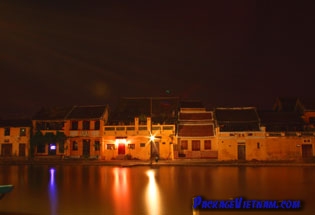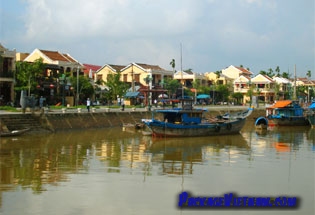
Hoi An
Hoi An is a riverine town 138 km south of Hue and 30km southeast of Da Nang. It was once a major international port trading in silk, ceramics, and spices.
The port town was called in frequently by merchants from China, Holland, Japan... in the 16th and 17th centuries. Merchants from China and Japan would take advantage of the spring wind to sail south to Hoi An. They would have to wait a few months until the autumn monsoon would carry them back home. Merchants from India, Arabian Peninsula and other western countries such as Holland, Portugal... would travel to Hoi An in autumn time and would journey back home in spring time.
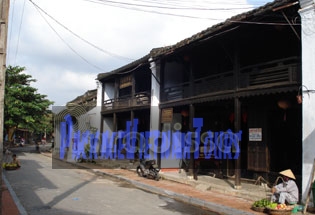
The old merchant houses in Hoi An Vietnam
Most merchants had some time waiting in Hoi An. Some merchants would stay full time in Hoi An taking advantage of trade with Vietnam or doing business with the international communities here; so they had to rent lodgings and warehouses. Hoi An formed and prospered then. And as a result, Hoi An has the fusion of international culture, especially the blend of Vietnamese, Chinese and Japanese.
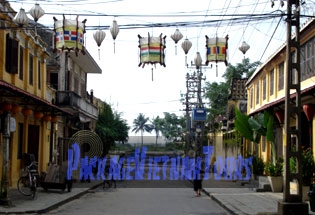
Street of Hoi An Old Town Vietnam
Much of Hoi An legacy survived time and war damages. All merchant houses still flank the narrow streets and alleys. Dotted in different corners of Hoi An are colorful Chinese Congregational Assembly Houses. The Thu Bon River still carries history flowing though the town into the sea at Cua Dai. The merchants of Hoi An are still busy with commerce keeping their century-old traditions.
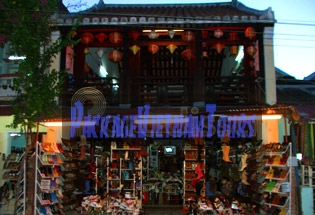
Shop house in Hoi An Old Town Vietnam
Traveling in Hoi An nowadays, you can still walk in the narrow alleys, enjoy the culinary delights and get lost in the shops with fine local products, be it fine silk, fine clothes, lacquerwares or ceramics...The only difference in the shopping experience here compared to other shopping havens is the inexpensive prices for equally fine quality.
Walking amid the quaint atmosphere of Hoi An Old Town you can still be carried back in times with overwhelming shops and porters busy with hand-push carts carrying goods to the harbors. You could still hear here and there the murmuring sounds of different languages. Pervading the air is the smell of mouth-watering Hoi An cuisine...
Hoi An Major Tourist Highlights
The Japanese Covered Bridge built 1593 separates the Japanese area from the rest of the town. There's a Buddhist pagoda attached to the side of the bridge. It's a nice experience touring the bridge and watch the locals busy walking or riding through.
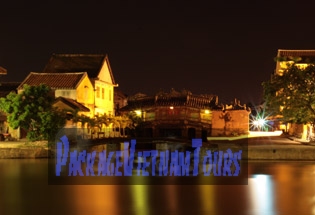
The Japanese bridge Hoi An Vietnam
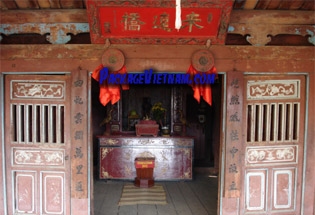
Bridge Pagoda Hoi An Vietnam
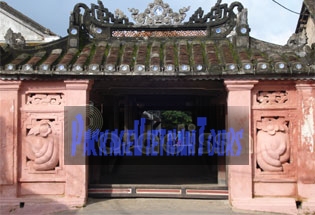
The Japanese Covered Bridge in Hoi An Vietnam
Museums: There are Hoi An Museum and Hoi An Ceramic Museum. Lots of antiquity including some salvaged from sunken ships off Hoi An coast are found here.
Old Merchant Houses have very nice architecture and are well-preserved. Most of them built from 15-19th centuries.
Chinese Congregational Assembly Houses are where the Chinese who came from different areas of China would have gatherings.
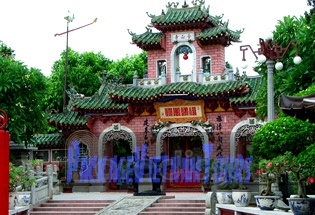
Phuc Kien Chinese Congregational Assembly
The Japanese tombs
The Thu Bon River
Hoi An Beach
Cu Lao Cham Island
Handicraft Villages
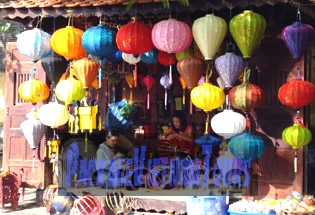
Making lantern in Hoi An
Travel and Tours
Hoi An has always been an unforgettable experience for our travelers. You may want to spend half a day for exploring the old town; from 1 to several days for shopping in the old town and for many days on the white powdery sand beach of Cua Dai. Some of you may want to use Hoi An as the base for day-tripping to
My Son Cham Ruins of Da Nang City or My Lai Massacre Site.
The tours normally starts with a walking tour of Hoi An Ancient Town. The tour would commence from the Japanese Area and the Japanese Covered-Bridge; then we continue onto an old Merchang Houses and a Chinese Congregational Assembly House. The tour would conclude at Hoi An Museum or Hoi An exotic Market. To reward ourselves for getting back to civilization after the tour back in time, we'll enjoy a cold beer on the riverfront.
Accommodation
There are many
hotels in Hoi An ranging from simple guest houses to luxurious 5 star hotels, resorts and spas. There are luxurious hotels and resorts on the Thu Bon River banks and on Hoi An Beach.
Getting there and away
Hoi An is 30km southeast of Da Nang which takes half an hour drive. From Da Nang to Hoi An you can hire a private car/taxi, motorbike taxi or hop onto a local commuter bus.
There's no airport around Hoi An, except for the one in Da Nang. From Ha Noi, Nha Trang, Ho Chi Minh City there are daily flights between Da Nang and those cities. The flight takes around 1 hour 20 minutes.
From Ho Chi Minh City, Nha Trang or Ha Noi there are nightly trains for Da Nang. There are soft-sleeper with air-conditioned carriages on the trains.
Hoi An is a good base for day-tripping to the Cham Ruins of My Son which is 70km away; or to the Massacre Site of My Lai which is 120km away.
Getting around
On foot: Hoi An Old Town is very small and can easily be explored on foot. This is also a pleasant way to experience the quaint atmosphere of Hoi An Town.
Bicycle: There are many hotels or shops renting out bicycles to tourists in town.
Motorbike: you can hire motorbikes from many shops in town for exploring the area around Hoi An. For within Hoi An area, there's no need for motorbikes. Motorbikes are not allowed in the old town of Hoi An.
Car/bus: Cars and buses are not allowed in the old town area.
Vietnam Travel Guides
- Activities
- Arts & Entertainment
- Bac Kan
- Bac Lieu
- Bac Ninh
- Battlefields
- Ben Tre
- Buon Ma Thuot
- Ca Mau
- Can Tho
- Cao Bang
- Cat Ba Island
- Chau Doc
- Climate
- Cu Chi Tunnel
- Da Lat
- Da Nang
- Dangers & Annoyances
- Economy
- Embassies & Consulates for Vietnam
- Embassies & Consulates of Vietnam
- Festivals & Events
- Food & Drinks
- Geography
- Gia Lai




 Print
Print 